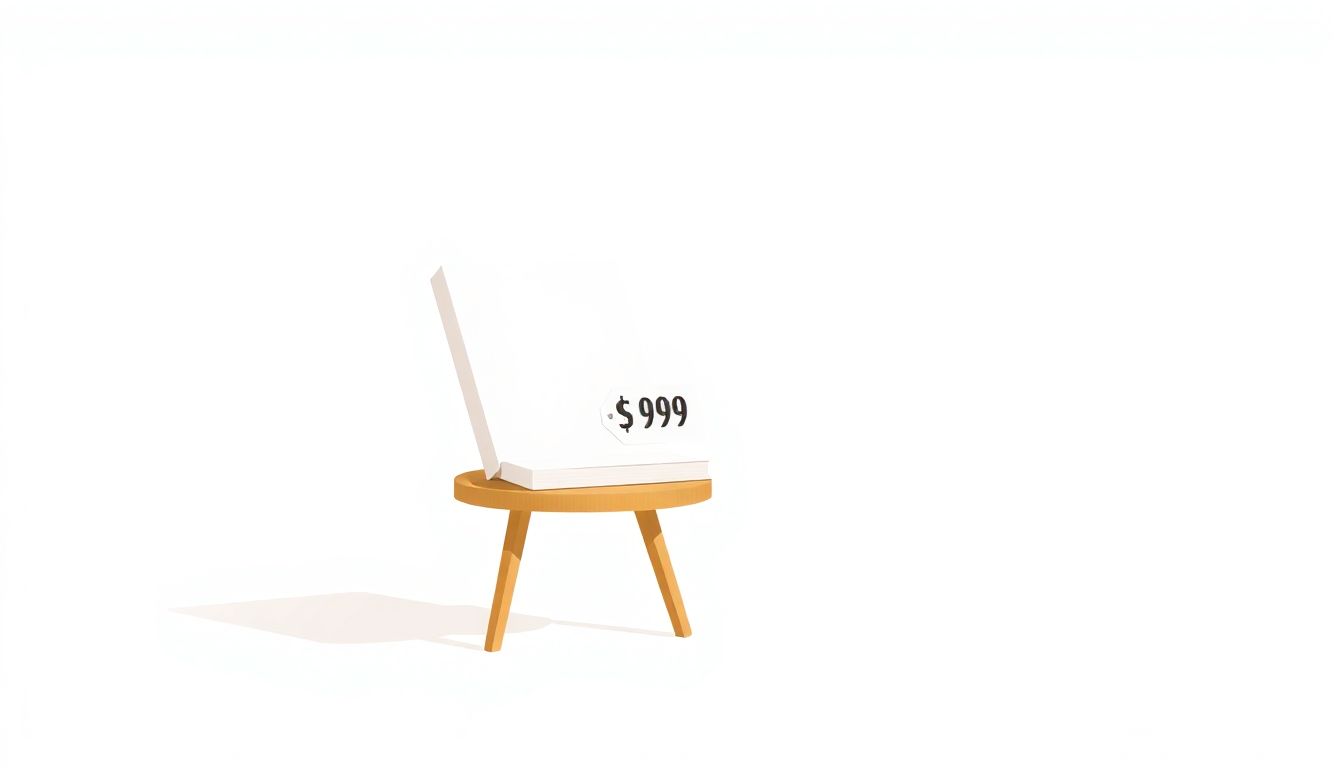Struggling to figure out how much to charge for your book? You’re not alone; it’s one of the trickiest decisions authors face.
But hey, don’t stress! Together we’ll explore the ins and outs of book pricing so you can confidently set the perfect price.
Sound good? Let’s jump in and make pricing your book a piece of cake.
Key Takeaways
- Identify your target audience to set a price they’ll accept.
- Research competitors to understand market pricing trends.
- Analyze market demand to gauge how much readers are willing to pay.
- Choose a pricing strategy aligned with your goals.
- Set different pricing ranges for different formats (e.g., ebook vs. hardcover).
- Apply psychological pricing techniques like charm pricing ($9.99 instead of $10).
- Test and adjust your pricing based on sales data and feedback.
- Regularly review sales performance to refine your pricing strategy.

How to Price Your Book Effectively
Ever wondered how to put a price tag on all those hours you spent crafting your book? It’s not just about covering costs; it’s about finding that sweet spot where readers feel excited to buy, and you feel fairly compensated. Let’s explore some practical steps to help you price your book effectively.
Pricing isn’t a one-size-fits-all deal. It involves understanding your audience, researching the market, and considering the value your book provides. By taking a thoughtful approach, you can set a price that appeals to readers and supports your goals as an author.
Identify Your Target Audience
First things first, who are you writing for? Understanding your target audience is crucial when setting your book’s price. Are your readers teens on a tight budget, or professionals willing to invest in quality content? Knowing your audience helps you choose a price point they’ll find acceptable.
Think about factors like age, income level, and reading habits. For example, if you’re writing a fantasy novel for young adults, pricing it too high might deter them. On the other hand, a specialized non-fiction book might justify a higher price due to its niche content.
If you’re unsure how to define your audience, here’s a helpful resource on understanding your target audience that can guide you through the process.
Research Your Competitors
Take a look at what similar books in your genre are selling for. This isn’t about copying others but understanding the market landscape. If most books like yours are priced between $10 and $15, setting your paperback at $25 might be a hard sell.
Browse online bookstores and visit local shops to see pricing trends. Pay attention to both print and digital formats. For instance, the average price of paperback books typically ranges between $10 and $20, while mass-market paperbacks can be as low as $5 to $10.
According to recent data, the average price of print books in the U.S. was around $16.38 in 2021. For more insights on ebook pricing, you might want to check out this guide on average ebook prices to help position your book competitively.
Remember, the goal is to price your book within a range that readers expect while still standing out from the crowd. Knowing what others are charging gives you a benchmark to make informed decisions.

Analyze Market Demand
Understanding how much readers are willing to pay for books like yours is crucial.
Consider the popularity of your genre and the current trends in the market.
For example, if you’re writing in a genre that’s seeing a surge in interest, you might have more flexibility with pricing.
On the other hand, if the market is saturated, a competitive price might make your book more appealing.
Keep in mind that in 2020, print books accounted for over 80% of total book sales in the U.S., indicating that many readers still prefer physical copies.
E-books constituted approximately 25% of all book sales, so there’s a significant audience for digital formats as well.
By analyzing market demand, you can tailor your pricing strategy to match reader preferences.
If you’re interested in exploring popular genres, this article on what type of e-books sell the most might provide some helpful insights.
Choose a Pricing Strategy
Now that you’ve got a handle on your audience, competitors, and market demand, it’s time to pick a pricing strategy.
There are several approaches you can take, depending on your goals.
If you’re a new author looking to build an audience, you might consider pricing your e-book on the lower end, perhaps between $0.99 and $4.99.
This can attract readers who are willing to take a chance on an unfamiliar name.
Alternatively, if your book offers unique value or you’re in a niche market, a higher price could signal quality and expertise.
Remember, digital books can range from $0.99 to $15, so there’s room to find a price that reflects your book’s worth.
Some authors use dynamic pricing, adjusting the price over time based on sales performance and reader feedback.
It’s all about finding a strategy that aligns with your goals and resonates with your readers.
Determine Pricing Ranges for Different Formats
Your book’s format plays a significant role in pricing.
Hardcover books generally cost more to produce and are often priced between $20 and $35.
Paperbacks are usually less expensive, typically ranging from $10 to $20.
Mass-market paperbacks can be as affordable as $5 to $10.
Digital books have lower production costs, so they often sell anywhere from $0.99 to $15.
Consider how each format impacts your costs and how much readers are willing to pay.
Offering multiple formats at different price points can widen your audience by catering to different preferences.
If you’re publishing a unique format like a coloring book, pricing strategies might differ.
You might find this guide on how to publish a coloring book helpful in understanding the nuances.
Apply Psychological Pricing Techniques
Sometimes, it’s not just about the price, but how the price is perceived.
Using psychological pricing strategies can make your book more enticing.
For instance, setting your book’s price at $9.99 instead of $10 can make it seem like a better deal.
This tactic, known as charm pricing, plays on the way we perceive numbers.
You can also create a sense of urgency by offering limited-time discounts or promotions.
Another idea is to price your e-book lower to encourage impulse buys, especially since digital books often range from $0.99 to $15.
Just remember to keep your pricing authentic; readers appreciate transparency.
Test and Adjust Your Pricing
Pricing isn’t set in stone, so don’t be afraid to experiment.
You can test different price points to see how your audience responds.
Many self-publishing platforms allow you to change your book’s price easily.
Try running promotions or temporary price reductions to boost visibility and gather data.
Pay attention to how changes in price affect your sales volume and revenue.
It’s all about finding the balance that works best for you and your readers.
If you’re using Amazon KDP, you might find this article on how much you can make from Amazon KDP useful for understanding potential earnings at different price points.
Review and Monitor Sales Performance
Once your book is out there, keep an eye on how it’s doing.
Regularly reviewing your sales data can provide valuable insights.
Look at which days you sell the most copies, or which formats are performing better.
If you notice a drop in sales, consider tweaking your price or running a promotion.
Monitoring reviews and feedback can also help you understand what readers value.
Remember, success doesn’t happen overnight, so stay patient and be willing to adapt.
For more ways to boost your book’s performance, check out these tips on how to increase book sales on Amazon.
FAQs
Research your target audience and competitors to understand what readers are willing to pay. Analyze similar books in your genre to find a competitive price that reflects your book’s value and appeals to potential buyers.
Yes, eBooks typically have lower production costs and are often priced lower than print versions. Offering different pricing for various formats can attract a wider audience and cater to different reader preferences.
New authors might consider competitive or penetration pricing to build an audience. Offering promotional discounts or using psychological pricing techniques, like ending prices with .99, can also encourage purchases.
Monitor your sales and gather feedback to see how price changes impact performance. Use A/B testing with different price points to identify which prices resonate best with your audience and optimize accordingly.
